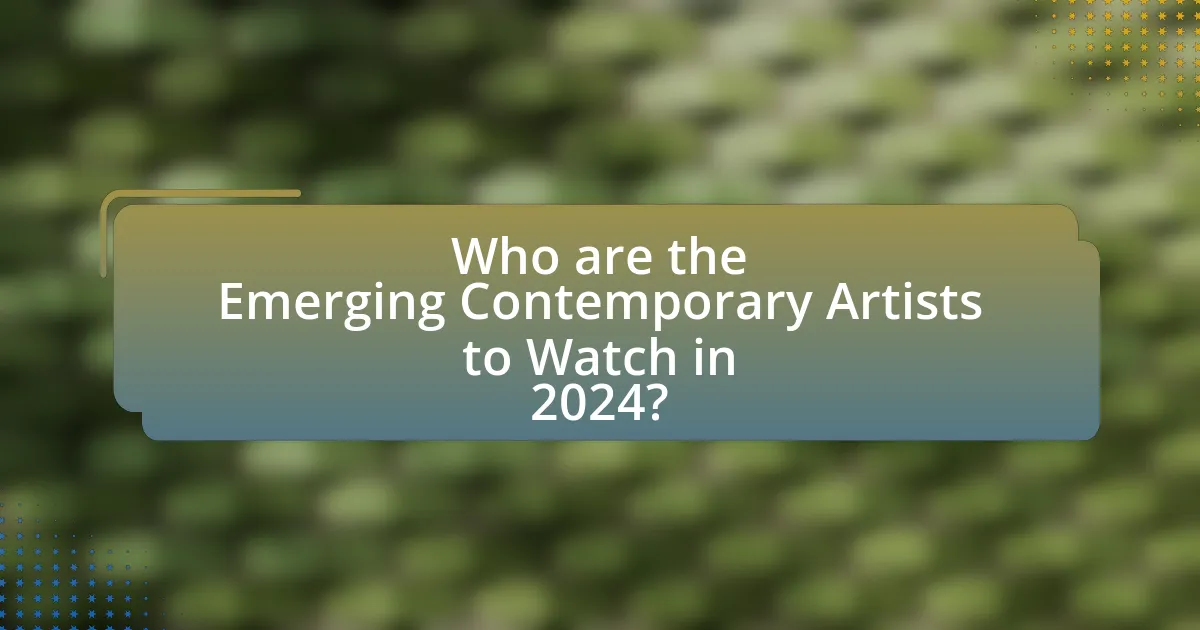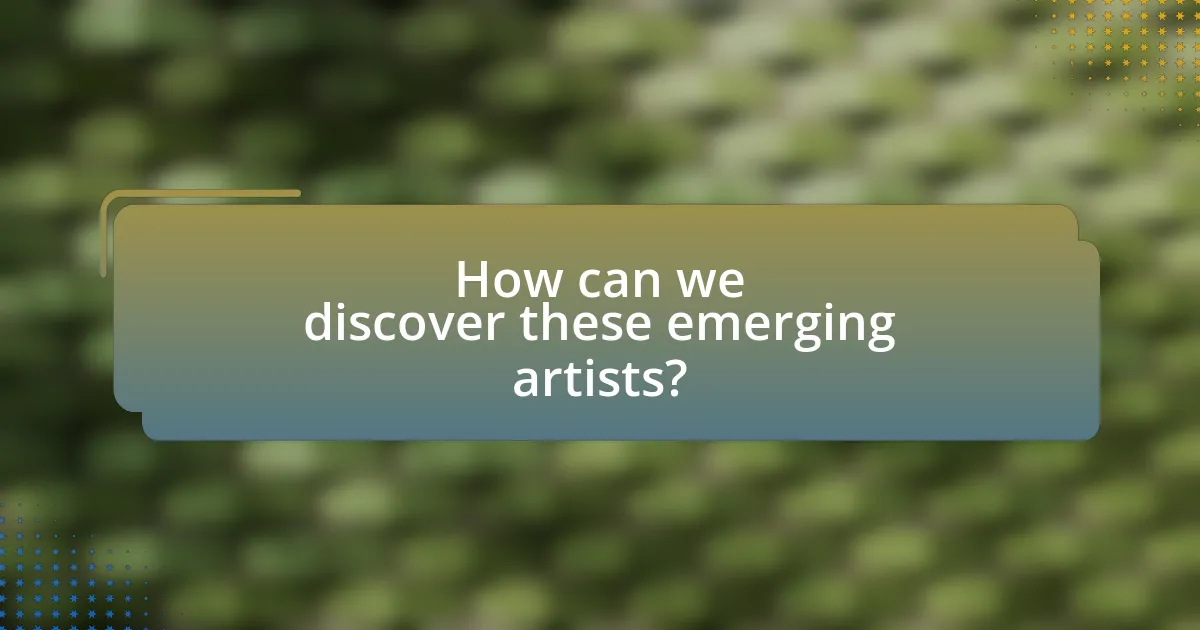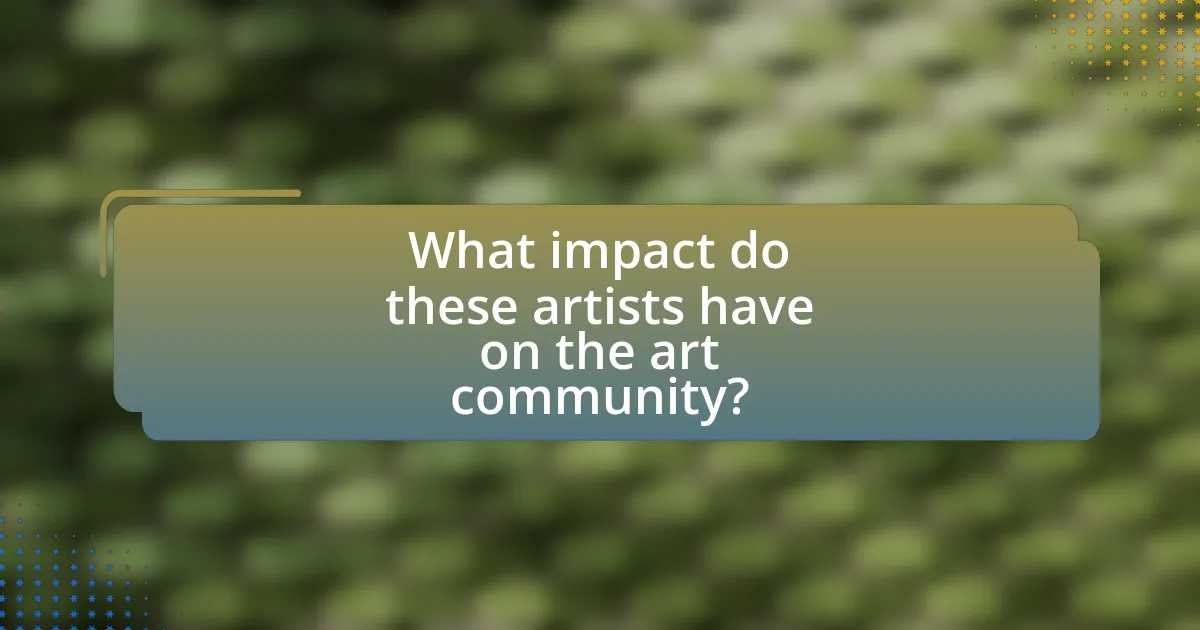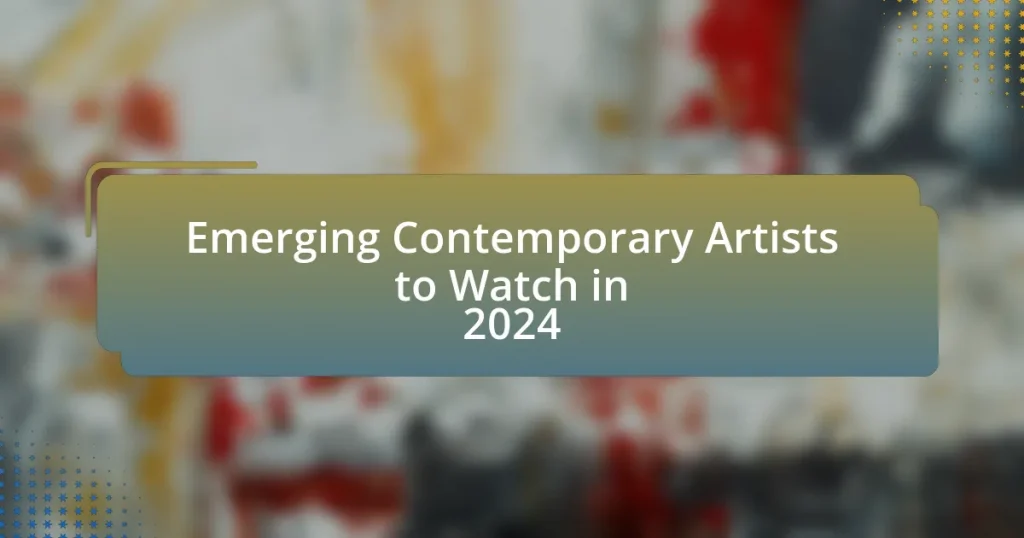The article focuses on emerging contemporary artists to watch in 2024, highlighting figures such as Jordan Casteel, Tschabalala Self, Shara Hughes, and Diedrick Brackens, who are recognized for their innovative approaches to themes of identity, race, and community. It defines emerging artists as those in the early stages of their careers, often gaining visibility through exhibitions and social media. The piece discusses the significance of 2024 for contemporary art, driven by global events and trends like digital art and social engagement. It also outlines how collectors can identify promising talent and the impact of these artists on the art community, emphasizing their role in challenging traditional norms and addressing contemporary issues.

Who are the Emerging Contemporary Artists to Watch in 2024?
Emerging contemporary artists to watch in 2024 include Jordan Casteel, known for her vibrant portraits that explore themes of identity and community, and Tschabalala Self, who combines painting and textile techniques to address race and gender. Additionally, artists like Shara Hughes, recognized for her colorful landscapes, and Diedrick Brackens, who uses weaving to comment on cultural narratives, are gaining significant attention. Their innovative approaches and critical engagement with contemporary issues position them as key figures in the art world for the upcoming year.
What defines an emerging contemporary artist?
An emerging contemporary artist is defined as an individual who is in the early stages of their artistic career, typically recognized for innovative practices and fresh perspectives within the contemporary art scene. These artists often exhibit their work in galleries or art fairs and may have limited but growing visibility in the art market. According to the Art Basel and UBS Global Art Market Report, emerging artists are crucial for the evolution of contemporary art, as they introduce new ideas and challenge existing norms. Their work often reflects current social, political, or cultural themes, making them relevant to contemporary discourse.
How do we identify emerging talent in the art world?
Emerging talent in the art world is identified through a combination of innovative artistic expression, participation in exhibitions, and recognition by critics and curators. Artists who demonstrate unique styles or concepts that resonate with contemporary themes often gain attention. For instance, platforms like Art Basel and the Venice Biennale showcase new artists, providing them visibility and opportunities for critical acclaim. Additionally, social media presence and engagement can amplify an artist’s reach, allowing them to connect with broader audiences and industry professionals. This multi-faceted approach ensures that emerging artists are not only recognized for their work but also for their potential to influence future art trends.
What criteria are used to evaluate these artists?
The criteria used to evaluate emerging contemporary artists include originality, technical skill, conceptual depth, and market potential. Originality assesses the uniqueness of an artist’s vision and style, while technical skill evaluates their proficiency in various artistic mediums. Conceptual depth examines the ideas and themes conveyed in their work, reflecting their ability to engage with contemporary issues. Market potential considers the artist’s ability to attract collectors and galleries, often influenced by their exhibition history and critical reception. These criteria collectively help curators, collectors, and critics determine the significance and viability of artists in the contemporary art landscape.
Why is 2024 a significant year for contemporary art?
2024 is significant for contemporary art due to the anticipated global art events and exhibitions that will showcase emerging artists, reflecting current societal issues and innovations. Major art fairs, such as Art Basel and the Venice Biennale, are set to feature a diverse range of contemporary works, emphasizing the importance of new voices in the art world. Additionally, the rise of digital art and NFTs continues to reshape the landscape, providing platforms for emerging artists to gain visibility and engage with broader audiences. This convergence of events and trends positions 2024 as a pivotal year for the evolution of contemporary art.
What trends are shaping the contemporary art scene in 2024?
In 2024, the contemporary art scene is being shaped by the rise of digital and immersive art experiences, as well as a strong focus on social and environmental themes. Artists are increasingly utilizing technology, such as virtual reality and augmented reality, to create interactive installations that engage audiences in new ways. Additionally, there is a growing emphasis on addressing pressing global issues, such as climate change and social justice, through artistic expression. This trend is evidenced by the increasing number of exhibitions and projects that prioritize sustainability and community engagement, reflecting a shift in the art world towards more socially responsible practices.
How are global events influencing emerging artists this year?
Global events are significantly influencing emerging artists this year by shaping their themes, mediums, and outreach strategies. For instance, the ongoing climate crisis has prompted many artists to incorporate environmental themes into their work, reflecting societal concerns and driving engagement with audiences who prioritize sustainability. Additionally, the COVID-19 pandemic has accelerated the use of digital platforms for showcasing art, leading to increased visibility for emerging artists through virtual exhibitions and online sales. According to a report by Artsy, 70% of artists have adapted their practices to include digital formats, demonstrating a clear shift in how art is created and consumed in response to global challenges.
What are the key characteristics of the artists to watch?
The key characteristics of artists to watch include innovation, distinct style, and strong engagement with contemporary issues. These artists often push boundaries in their medium, whether through unique techniques or unconventional materials, showcasing originality that sets them apart. Additionally, they typically possess a clear and recognizable aesthetic that resonates with audiences, making their work memorable. Furthermore, many of these emerging artists address relevant social, political, or environmental themes, reflecting current societal conversations and connecting with viewers on a deeper level. This combination of creativity, individuality, and relevance positions them as significant figures in the contemporary art scene.
How do their backgrounds influence their artistic styles?
Artists’ backgrounds significantly shape their artistic styles by informing their perspectives, techniques, and subject matter. For instance, an artist raised in a culturally rich environment may incorporate traditional motifs and narratives into their work, reflecting their heritage. Additionally, personal experiences, such as socioeconomic status or exposure to various art forms, can lead to unique stylistic choices; artists from urban backgrounds might adopt street art influences, while those from rural settings may emphasize natural landscapes. Historical context also plays a role; artists influenced by significant cultural movements or events often channel these experiences into their art, resulting in styles that resonate with broader societal themes.
What themes are prevalent in their works?
Emerging contemporary artists in 2024 often explore themes of identity, social justice, and environmental consciousness. These artists frequently address personal and collective narratives, reflecting on cultural heritage and the complexities of modern life. For instance, many utilize mixed media to comment on systemic inequalities, drawing attention to issues such as race, gender, and class. Additionally, a significant focus on sustainability and climate change is evident, as artists incorporate eco-friendly materials and practices into their work, emphasizing the urgent need for environmental awareness. This thematic diversity not only showcases their individual perspectives but also resonates with broader societal conversations, making their works relevant and impactful.

How can we discover these emerging artists?
To discover emerging artists, one can utilize platforms like social media, art fairs, and online galleries that showcase new talent. Social media platforms such as Instagram and TikTok allow artists to share their work widely, making it easier for audiences to find and follow them. Art fairs, like Frieze and Art Basel, often feature sections dedicated to emerging artists, providing direct access to their work. Online galleries and websites, such as Artsy and Saatchi Art, curate collections of new artists, allowing for easy exploration of their portfolios. These methods are effective as they leverage current trends in digital engagement and community building within the art world.
What platforms showcase emerging contemporary artists?
Platforms that showcase emerging contemporary artists include Instagram, Artsy, Saatchi Art, and Artfinder. Instagram serves as a visual social media platform where artists can share their work and connect with audiences globally, leading to increased visibility and opportunities. Artsy is an online marketplace that features a wide range of contemporary art and artists, allowing collectors to discover new talent. Saatchi Art provides a platform for artists to sell their work directly to buyers, promoting emerging artists through curated collections. Artfinder focuses on original art and connects buyers with independent artists, emphasizing unique and diverse artistic expressions. These platforms collectively enhance the exposure and marketability of emerging contemporary artists.
How do social media and online galleries play a role?
Social media and online galleries significantly enhance the visibility and accessibility of emerging contemporary artists. These platforms allow artists to showcase their work to a global audience, facilitating connections with potential buyers, collectors, and art enthusiasts. For instance, Instagram has become a primary tool for artists to share their portfolios, with over 1 billion active users, enabling artists to reach diverse demographics and engage directly with their audience. Online galleries, such as Saatchi Art and Artsy, provide curated spaces for artists to exhibit their work, often leading to increased sales and opportunities for collaboration. This digital presence not only democratizes the art world but also fosters community and dialogue around contemporary art trends.
What art fairs and exhibitions should we attend in 2024?
In 2024, key art fairs and exhibitions to attend include Art Basel in Miami Beach, Frieze Los Angeles, and The Armory Show in New York. Art Basel Miami Beach, scheduled for December, showcases leading contemporary artists and galleries, making it a pivotal event for discovering emerging talent. Frieze Los Angeles, taking place in February, features a diverse range of contemporary art and is known for highlighting new artists. The Armory Show, occurring in September, focuses on modern and contemporary art, providing a platform for both established and emerging artists. These events are essential for anyone interested in the latest trends and talents in the contemporary art scene.
What resources are available for following these artists?
Resources available for following emerging contemporary artists include social media platforms, artist websites, and online art marketplaces. Social media platforms like Instagram and Twitter allow users to follow artists directly, providing real-time updates on their work and exhibitions. Artist websites often feature portfolios, upcoming shows, and contact information, serving as a central hub for their latest projects. Online art marketplaces such as Artsy and Saatchi Art enable users to discover and purchase artworks while also offering insights into artists’ backgrounds and practices. These resources collectively enhance visibility and accessibility to the artists’ work and careers.
How can art enthusiasts stay updated on new talent?
Art enthusiasts can stay updated on new talent by following art blogs, attending gallery openings, and subscribing to newsletters from art institutions. These platforms often feature emerging artists and provide insights into their work and exhibitions. For instance, websites like Artsy and Hyperallergic regularly highlight new talent and upcoming exhibitions, while social media platforms like Instagram allow artists to showcase their work directly to audiences. Additionally, art fairs such as Art Basel and Frieze are excellent venues for discovering emerging artists, as they often include sections dedicated to new talent.
What publications focus on emerging contemporary artists?
Publications that focus on emerging contemporary artists include “Artforum,” “Frieze,” and “Hyperallergic.” These publications regularly feature articles, reviews, and profiles that highlight new talent in the contemporary art scene. For instance, “Artforum” often includes sections dedicated to emerging artists in its reviews and exhibition listings, while “Frieze” publishes a dedicated section for emerging talent in its magazine and online platform. “Hyperallergic” also emphasizes emerging artists through its coverage of exhibitions and artist interviews, providing a platform for new voices in the art world.

What impact do these artists have on the art community?
Emerging contemporary artists significantly influence the art community by introducing innovative techniques and diverse perspectives. These artists challenge traditional norms, fostering a dynamic environment that encourages experimentation and dialogue. For instance, artists like Jordan Casteel and Toyin Ojih Odutola have gained recognition for their unique approaches to representation and identity, which resonate with broader social issues. Their work not only enriches the artistic landscape but also engages audiences in critical conversations about culture and society, thereby shaping the future of contemporary art.
How do emerging artists challenge traditional art norms?
Emerging artists challenge traditional art norms by utilizing innovative techniques and diverse mediums that defy conventional boundaries. For instance, many of these artists incorporate technology, such as digital art and augmented reality, to create immersive experiences that traditional forms cannot replicate. Additionally, they often address contemporary social issues, pushing the narrative of art beyond aesthetic value to include activism and commentary. This shift is evident in the rise of street art and installation pieces that engage public spaces, making art accessible to wider audiences. The impact of these approaches is reflected in exhibitions and art fairs, where non-traditional works gain recognition and challenge established art market hierarchies.
What innovations are they bringing to contemporary art?
Emerging contemporary artists are bringing innovations to contemporary art through the integration of technology, interactive installations, and social commentary. These artists utilize digital mediums, such as virtual reality and augmented reality, to create immersive experiences that engage audiences in new ways. For instance, artists like Refik Anadol employ data-driven algorithms to transform complex datasets into visual art, challenging traditional notions of creativity and authorship. Additionally, many emerging artists focus on themes of identity, climate change, and social justice, using their work to provoke dialogue and inspire action. This approach not only reflects current societal issues but also expands the role of art as a catalyst for change.
How do they engage with social and political issues through their work?
Emerging contemporary artists engage with social and political issues through their work by incorporating themes of activism, identity, and community into their art. For instance, many artists utilize mixed media, installations, and public art to address topics such as climate change, racial inequality, and gender rights. Specific examples include artists who create immersive experiences that challenge viewers to confront societal injustices, thereby fostering dialogue and awareness. This approach not only reflects current events but also encourages audience participation and reflection, making the art a catalyst for social change.
What role do collectors play in supporting emerging artists?
Collectors play a crucial role in supporting emerging artists by providing financial backing and validation of their work. When collectors purchase art from new artists, they not only offer immediate monetary support but also enhance the artist’s credibility within the art community. This validation can lead to increased visibility, opportunities for exhibitions, and further sales. According to a report by Art Basel and UBS, 70% of collectors believe that their purchases help to promote the careers of emerging artists, demonstrating the significant impact collectors have on the sustainability and growth of new talent in the art world.
How can collectors identify promising talent?
Collectors can identify promising talent by analyzing an artist’s unique style, exhibition history, and critical reception. A unique style often indicates originality and potential for future growth, while a strong exhibition history demonstrates an artist’s ability to engage with audiences and curators. Additionally, positive critical reception in reputable art publications can serve as a validation of an artist’s work, suggesting they are gaining recognition in the art community. Collectors should also consider the artist’s participation in emerging art fairs and their connections within the industry, as these factors can influence their trajectory and market value.
What are the benefits of investing in emerging artists?
Investing in emerging artists offers the potential for significant financial returns, as their work can appreciate in value over time. Emerging artists often create innovative and unique pieces that resonate with contemporary trends, attracting collectors and art enthusiasts. According to a report by Artprice, the market for contemporary art has seen a 10% annual growth rate, indicating that early investments in emerging talent can yield substantial profits as these artists gain recognition. Additionally, supporting emerging artists contributes to the diversification of the art market, fostering creativity and cultural development.
What are some practical tips for engaging with emerging contemporary artists?
To effectively engage with emerging contemporary artists, attend their exhibitions and openings to experience their work firsthand and interact with them directly. This approach fosters personal connections and provides insights into their artistic processes. Additionally, following them on social media platforms allows for ongoing engagement and support, as many artists share updates, thoughts, and behind-the-scenes content. Participating in artist talks or panel discussions can deepen understanding of their perspectives and motivations. Furthermore, purchasing their work or supporting their projects through crowdfunding can significantly impact their careers, as financial support is crucial for emerging artists. Engaging in these activities not only enriches the relationship with the artists but also contributes to the broader art community.















